Summary
-
As the name implies, Fusarium wilt of Canary Island date palm is primarily observed on Phoenix canariensis (Canary Island date palm).
-
The disease is caused by the fungus Fusarium oxysporum f. sp. canariensis.
-
The leaf symptoms include a one-sided death, wherein the leaflets on only one side of the rachis are desiccated or dead. This is often accompanied by a reddish-brown or dark-brown streak on the petiole and rachis on the same side as the desiccated or dead leaflets. Eventually, the entire leaf dies.
-
The disease symptoms normally appear first on the oldest (lowest) living leaves, and then progressively move upward in the canopy until the palm is killed.
-
The only other disease that these symptoms could be confused with is petiole/rachis blight.
-
Transmission of the fungus from palm to palm is primarily through contaminated pruning tools.
-
There is no cure for this lethal disease. Fungicides have not been effective against Fusarium wilt.
-
Since there is no cure, disease management is aimed at disease prevention. A new or disinfected pruning tool should be used for pruning leaves from each individual Canary Island date palm.
-
A laboratory diagnosis using molecular techniques is required to confirm the Fusarium wilt pathogen.
Introduction
Unlike most fungal diseases of palms, this disease is very host specific, with the primary host being Phoenix canariensis (Canary Island date palm). It is caused by Fusarium oxysporum f. sp. canariensis. The name "Fusarium wilt of Canary Island date palm" was given to this disease to distinguish it from three other Fusarium wilt diseases that occur on palms. Fusarium wilt of Canary Island date palm was first documented in the United States in the 1970s in California, but it was not documented in Florida until 1994. It now occurs throughout the state.
The fungus causes a vascular wilt. Specifically, it obstructs the xylem (water-conducting) tissue, which results in desiccation and death, as described below.
The fungus produces short-lived spores (macroconidia and microconidia). It also produces chlamydospores, spores that live in the soil and plant tissue for long time periods (usually years). Because most of the root system is left behind after a palm dies from this disease, this mass of roots may act as a reservoir for the fungus for a long time.
Experimental and observational evidence suggests that other Phoenix species may be susceptible to Fusarium oxysporum f. sp. canariensis, including Phoenix dactylifera (date palm), Phoenix reclinata (Senegal date palm), and Phoenix sylvestris (wild date palm), but actual cases in the landscape or field nursery in Florida are extremely rare when compared to cases associated with Phoenix canariensis.
The second Fusarium wilt disease of palms that occurs in Florida is "Fusarium wilt of queen and Mexican fan palm," which primarily occurs on Syagrus romanzoffiana (queen palm) and Washingtonia robusta (Mexican fan palm). This disease is caused by Fusarium oxysporum f. sp. palmarum. See https://edis.ifas.ufl.edu/pp278 for more information on this disease.
Palm Anatomy
To understand the symptoms described below, the terminology regarding palm anatomy must be defined. Phoenix species are an example of a pinnate or feather-leaf palm. The entire leaf is often called a frond. The leaf consists of a blade, a petiole, and a leaf base. The leaf base is the broad section that attaches to the trunk. The petiole is the "stem" of the leaf from the leaf base to the point where leaflets begin to attach to it. On a feather-leaf palm, the extension of the petiole into the leaf blade where all the leaflets attach is called the rachis. The leaflets are often referred to as pinnae.
Symptoms
Although the name "Fusarium wilt" implies that the primary symptom is a wilt, vascular wilts in palms look different from wilt diseases of hardwood trees. Instead of limp leaves or leaflets, they cause leaf desiccation and eventually leaf death symptoms. As with any disease, a progression of symptoms is observed with Fusarium wilt. Initial symptoms normally occur on the lowest (oldest) living leaves (Figure 1). Leaflets, either all of them or only a portion, ans on only one side of the rachis, are discolored, usually a shade of brown because of desiccation or death. The leaflets on the opposite side of the rachis are healthy. This very distinctive symptom is often referred to as a "one-sided wilt" or "one-sided death" (Figure 2). Eventually, the leaflets on the other side of the rachis turn brown also, and the entire leaf dies.

Credit: M. L. Elliott, UF/IFAS
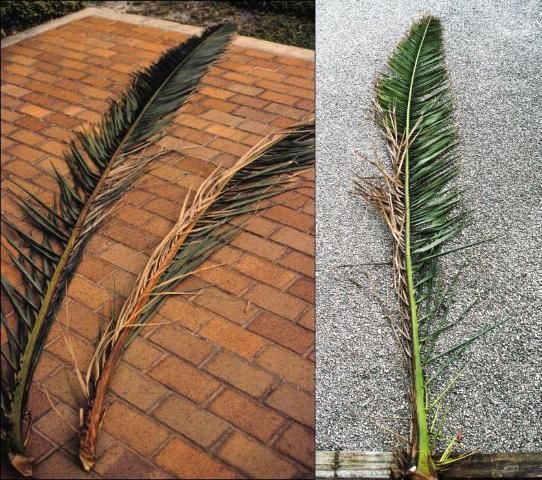
Credit: T.K. Broschat and M. L. Elliott, UF/IFAS
A reddish-brown or dark-brown streak or stripe can be observed on the petiole and rachis of the affected frond, initially on the same side where the first dead leaflets appeared (Figure 3), and usually beginning at or near the leaf base (Figure 2). This streak may run the full length of the petiole and rachis or just a portion of it. Internal discoloration can be observed in cross section (Figure 4). This internal discoloration is caused by the fungus infesting the xylem tissue.
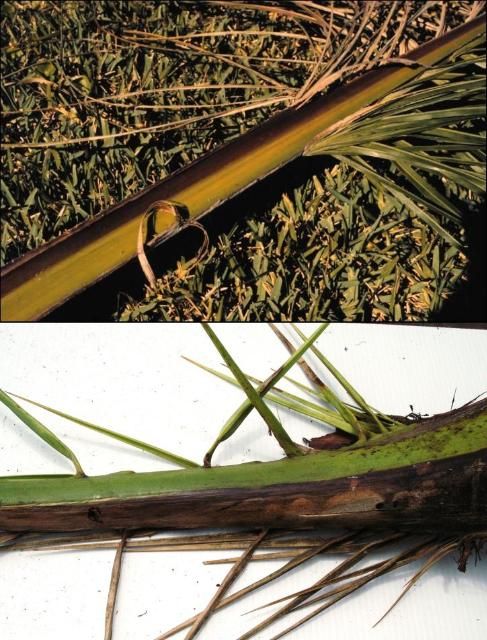
Credit: N. A. Harrison and M. L. Elliott, UF/IFAS
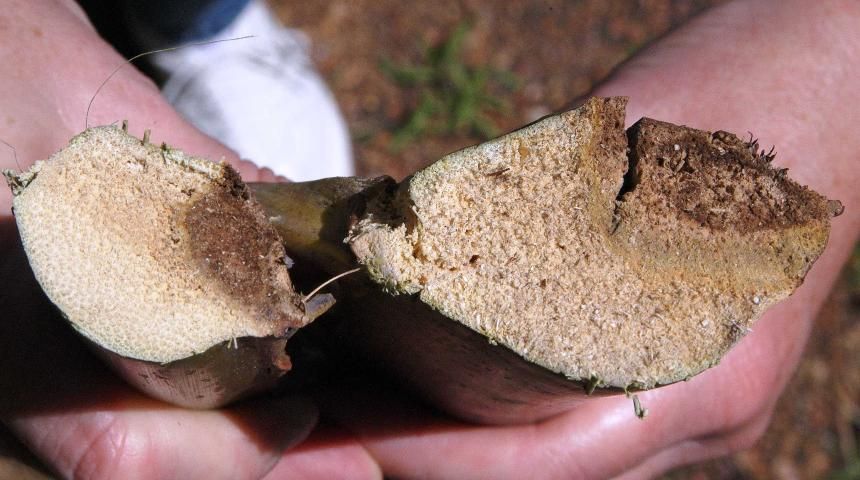
Credit: M. L. Elliott, UF/IFAS
The disease symptoms normally begin on the lowest (oldest) leaves and then move up the canopy, progressively killing younger and younger leaves. The palm may die relatively quickly (within months), but it usually lingers for as long as a year. The reason for this disparity is not known.
Possible symptom variations include the disease initially starting mid-canopy rather than at the bottom of the canopy, perhaps because flower or fruit stalks were trimmed with an infested pruning tool. For some leaves, the leaflets may begin turning brown at the leaf tip and on both sides at once, rather than just on one side. It has also been noted that palm weevils in the bud of Fusarium wilt-stressed palms hasten the palm's decline and may complicate determining the cause.
Diagnosis
Field diagnosis can often be made based on the symptoms described above, especially if the symptoms are typical ones. But symptoms of Fusarium wilt look the same as petiole/rachis blight. The latter is not a true vascular wilt and usually does not kill the palm, but the resulting individual leaf symptoms are very similar on Phoenix species. See the fact sheet about this disease at https://edis.ifas.ufl.edu/pp145. It is also possible for a Canary Island date palm to have both diseases. Therefore, a laboratory diagnosis is required to confirm Fusarium wilt.
To confirm the field diagnosis, a laboratory must isolate a Fusarium oxysporum-like fungus from the affected leaf tissue and then conduct a molecular test on the isolated culture to confirm it is f. sp. canariensis. Contact your local county Extension office or the Florida Extension Plant Diagnostic Clinic (http://www.plantclinic.org) for complete details about correct sample submission procedures and cost of a laboratory diagnosis. The best tissue to send for a diagnosis is the petiole or rachis from a leaf exhibiting the typical symptoms of one-sided wilt. A dead leaf is not acceptable.
Molecular confirmation of the isolated fungus is critical. There are numerous Fusarium oxysporum isolates that do not cause disease but may be associated with palm material. Unfortunately, it is not possible to separate pathogenic isolates from nonpathogenic isolates based on their appearance in culture. Thus, isolating a fungus that looks like F. oxysporum does not confirm the field diagnosis. The fungus growing on the culture plate must be subjected to a molecular test that is specific for F. oxysporum f. sp. canariensis.
If the field symptoms appear typical for Fusarium wilt, but Fusarium is not isolated, then the symptoms may be an expression of petiole/rachis blight. Many of the petiole/rachis blight pathogens are not culturable from plant tissue. The next step would be to obtain new samples from the diseased palm or similarly diseased palm and resubmit to the clinic to confirm presence or absence of petiole/rachis blight pathogens. Be sure to discuss the problem with the clinic staff before resubmitting samples. If no symptomatic leaves are available, wait until new symptoms develop before resubmitting.
Disease Management
There are no cures for this disease. Fungicides have been evaluated, but none have been effective. Disease management is based solely on disease prevention.
The fungus is most likely moved between distant locations by plant material, both live plants and probably seed. This is probably how the disease was first introduced (and reintroduced) into Florida. Unpublished research from both Florida and Australia has demonstrated the fungus can colonize palm seeds. This makes it critical for palm nurseries to know that their seed and stock plants are coming from a disease-free source. Likewise, nursery growers, landscape architects, and installation companies should examine and select Canary Island date palms while they are still in the field or on site at a container nursery and make this inspection prior to any trimming of older leaves so the plants can be inspected for symptoms. Then, they should either monitor the trimming of these palms to ensure they are trimmed correctly or trim them at the installation site using the correct procedure discussed below.
Once the disease is established in a landscape or nursery, the disease appears to primarily be transmitted from palm to palm via leaf pruning equipment (Figures 5 and 6). The fungal pathogen is in the vascular tissue of the leaf. Equipment used to remove leaves from an infected Canary Island date palm (chain saw, lopper, pruning shear, handsaw, etc.) will have fungal-infested leaf material (wood dust, plant sap) on the blades. If that equipment is not cleaned and disinfected, the next Canary Island date palm (and perhaps other Phoenix species) pruned by this equipment will be exposed to this fungal-infested leaf material.
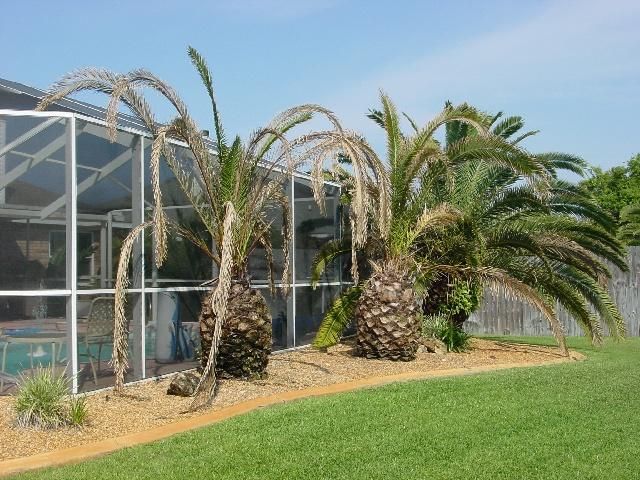
It is important to note that a palm could be infected but appear healthy (symptomless) because the disease has not developed to the point that leaf symptoms are being expressed. Unfortunately, it is not known how long this infected but symptomless stage of the disease lasts. It could be 6–18 months. Thus, the fungus could still be moved from palm to palm by pruning infected but symptomless leaves!
This means Canary Island date palms should be pruned with either new pruning tools or clean, disinfected tools, both in the landscape and nursery. This applies to all Canary Island date palms, diseased and healthy. Either a new pruning tool or a clean, disinfected pruning tool should be used for each individual palm. Pruning should be limited to once each year. Furthermore, pruning should be restricted to removal of only dead or dying leaves. Severe pruning, such as "hurricane cuts" or "pineapple cuts," weakens trees and increases the risk of pathogen transmission. Pruning should be viewed as a risk factor for Fusarium wilt disease transmission and not as a benefit to the Canary Island date palm.
Table 1 is a list of materials that can be used as disinfecting agents. Brush the tool blades clean of debris before placing in the disinfectant solution. For chain saws, it is recommended that they be taken apart and both the chain and bar soaked. By having multiple pruning tools, one tool can be soaking in the disinfectant solution in a bucket while the other tool is used for pruning. Alternatively, a newly developed pruning saw disinfecting tube with disinfectant solution can be attached to your belt (www.bladebath.com).The disinfectant solution should be replaced at least every 10 trees or every 2 hours. Rinse tools with clean water before pruning.
The following is a management suggestion: For the initial installation of a Canary Island date palm, it is normal to remove a large number of fronds. Using a handsaw would be time consuming, so either use a new chainsaw or disinfect the chainsaw between each palm. After installation, the number of leaves pruned should be limited as only dead leaves should be removed. This can be accomplished with a new pruning tool for each palm.
While this is an extraordinary measure, it is inexpensive disease prevention management for extremely valuable palms. A mature Canary Island date palm that has died from Fusarium wilt is expensive to remove and expensive to replace. It is certainly more economical to prevent the disease than deal with the deadly consequences, especially if there are multiple Canary Island date palms in the landscape (Figure 6). Using a new pruning tool or disinfecting the pruning tool is inexpensive in comparison to a devastated landscape.
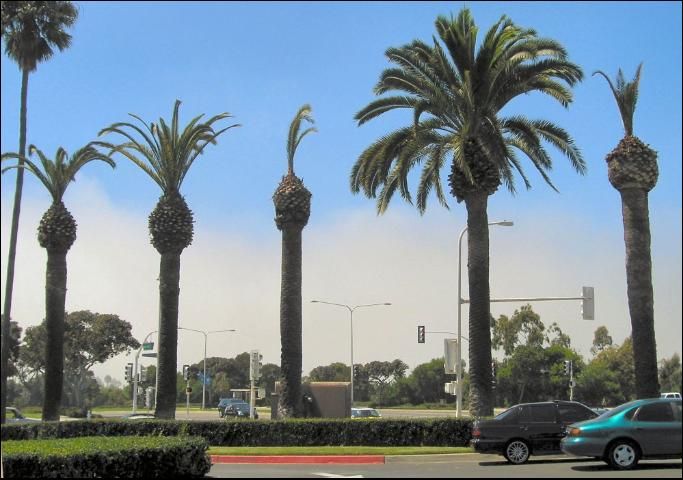
Credit: H. M. Donselman
Again, this is a disease without a cure. In a nursery situation, diagnosis of this disease effectively destroys the crop as the plants are unsaleable and must be destroyed. In the landscape situation, the palm eventually dies and must be removed. In both situations, but especially the nursery situation, the diseased palm(s) should be removed and destroyed immediately. Be very careful not to distribute potentially fungal-infested soil or potting mix in the nursery. Surrounding Canary Island date palms should be monitored closely because it is quite likely they could be infected.
The diseased palm should be incinerated or placed in a landfill. If this is not possible (as is the case in many Florida counties), then be sure the palm is not chipped and recycled for mulch in the landscape. Instead, chipped material should be placed in a compost pile. Chain saws and other tools used for removal must be brushed free of plant material and disinfected as described previously.
Chlamydospores of Fusarium oxysporum f. sp. canariensis can survive for long periods in the soil and certainly will survive in any infected root mass left behind when a diseased palm is removed. Experimental and observational evidence has shown the potential for infecting palms, especially seedling palms, with this fungus via the root system. Therefore, it would not be prudent to plant a Canary Island date palm back into a site where Fusarium wilt killed the previous palm(s). It is not known how far away from the potentially fungal-infested site one must move before it is safe to plant a Canary Island date palm.
Selected References
Feather, T. V. 1982. "Occurrence, Etiology and Control of Wilt and Dieback of Phoenix canariensis in California." Ph.D. diss. University of California, Riverside, CA.
Feather, T. V., D. E. Munnecke, and J. B. Carpenter. 1989. "The Occurrence of Fusarium oxysporum on Phoenix canariensis: A Potential Danger to Date Production in California." Plant Disease 73 (1): 78–80. https://doi.org/10.1094/PD-73-0078
Plyler, T. R., G. W. Simone, D. Fernandez, and H. C. Kistler. 1999. "Rapid Detection of the Fusarium oxysporum Lineage Containing the Canary Island Date Palm Wilt Pathogen." Phytopathology 89 (5): 407–413. https://doi.org/10.1094/PHYTO.1999.89.5.407
Simone, G. W. 1998. Prevention and Management of Palm Diseases in Florida's Landscapes. Plant Pathology Mimeo 98-4. Gainesville: University of Florida Cooperative Extension Service.
Simone, G. W. 2004. "Fusarium Wilt." In Compendium of Ornamental Palm Diseases and Disorders, edited by M. L. Elliott, T. K. Broschat, J. Y. Uchida, and G. W. Simone, 17–25. St. Paul, MN: American Phytopathological Society.
Simone, G. W., and G. Cashion. 1996. Fusarium Wilt of Canary Island Date Palms in Florida. Plant Pathology Fact Sheet PP-44. Gainesville: University of Florida Cooperative Extension Service.
Smith, D. I., I. W. Smith, and P. Clements. 2003. Fusarium Wilt of Canary Island Date Palm. Forests Fact Sheet, Victoria, Australia: Department of Sustainability and Environment.
Summerell, B. A., H. C. Kistler, and L. V. Gunn. 2001. "Fusarium Wilt of Phoenix canariensis Caused by Fusarium oxysporum f. sp. canariensis." In Fusarium: Paul E. Nelson Memorial Symposium, edited by B. A. Summerell, J. F. Leslie, D. Backhouse, W. L. Bryden, and L. W. Burgess, 263–270. St. Paul, MN: American Phytopathological Society.